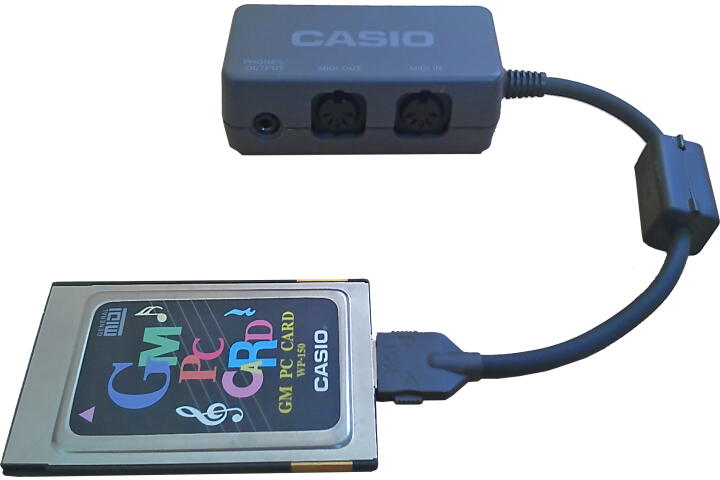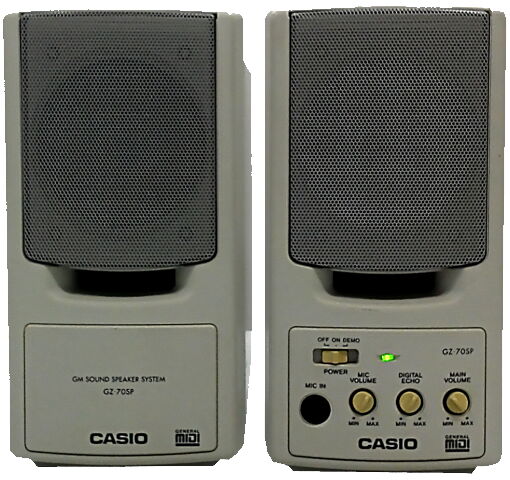For the earlier version of the SW-10 softsynth, I'll have to check whether it's included with the Lana Karaoke program on my GZ-70SP's CD-ROM. The version at the download link in the first post is 1.03, while the software on my CD-ROM is identified as version 1.0 in the documentation.
BTW, interesting tidbit from the Lana Online manual: the Acoustic Laboratory of Waseda University and one Prof. Dr. Yoshio Yamasaki are credited in the "Project Staff" paragraph. That might suggest some of the technology in the software originated at that university.
Edit: Some more digging has turned up the following on the GZ-series:
- GZ-30M has no MIDI IN port, it needs to be connected to a computer via serial connection to work. It only has a power connector and power switch, MIDI source switch (with only PC1, PC2, and MAC choices), TO HOST connector, volume slider, and headphones OUT. Despite sharing the basic hardware with the GZ-70SP it has the full 32 voices of polyphony (and so does the WG-130 wavetable daughter board).
- The latter really implies the 8 missing voices are taken up by something else on the GZ-70SP. My take is that the situation is similar to that of Yamaha's MU10 and that the voices are used for at least the line IN connections, which would account for at least 3 of the 8 missing voices (1x for mono MIC IN, 2x for stereo line IN).
- The WG-130 daughter board has room on the PCB for a DSP chip and associated ROM.
- So the GZ-30/70/WG-130 family lacks the integrated effects because they are supposed to be used with separate effect chips (implemented as a separate digital echo on the 70).
- Except for effects, the MIDI implementation chart is 100% the same as for the GZ-50M.
- However, the sound set is different. Comparing the GZ-70SP sounds set to that of the GZ-50M, the following use different instrument names: Organ 16 & 17, Guitar 24/25/27/29, Bass 32/33/34, Ensemble 52 (maybe only name) & 52, Synth-lead 80/81/82/83/84/85, all of Synth-pad except first one, Synth-sfx 96/101/103, Ethnic 108, Percussion 112/117/118. On top of that, the GZ-70SP uses 2 voices for certain sounds, while no difference between number of voices used is shown in the GZ-50M service manual.
- Furthermore, they have a total of 8 drum sets versus a single one on the GZ-50M, covering notes E1-E6 instead of B1-C6. The standard drum set is different.
- GZ-30M, GZ-70SP, WG-130 all use a suspiciously named Casio chip GM16000N-C40, which is still available today and which very well may contain the instrument data, if "GM" stands for "General MIDI"... So if anyone wants to build a modern wavetable daughter board, they could maybe try that chip...
- The chips are also supposedly shared with Casio's home keyboards of the day...so if you want Casio General MIDI, you could also pick up a Casio home keyboard that has MIDI IN.
- There is a full size 61-key MIDI keyboard called the GZ-500, supposedly based on the GZ-50M, which was apparently also sold outside Japan. The service manual can be found here: http://www.warningwillrobinson.com.au/manuals … ce%20manual.pdf. This one is actually interesting in that it comes at a time Casio was pretty much getting out of the more professional keyboard market.
Edit 2: Managed to find the old Faith (maker of Lana etc.) website via the wayback machine. So:
DevanWolf wrote:Other than GZ-50M, there is an extremely rare WP-150. It's a PCMCIA card version of the GZ-50M. Man, it's really hard to find in […]
Show full quote
Other than GZ-50M, there is an extremely rare WP-150. It's a PCMCIA card version of the GZ-50M. Man, it's really hard to find in online store!

And someone here is saying something sounding like GZ-70SP, yet there is a GZ-70SP which is Japan only exclusive. (Might want to import it) It lacks the reverb/effect section though.

These might have been sold not only under the Casio name, but also directly by Faith. See https://web.archive.org/web/20000118094513/ht … com/cmmutn2.htm
CASIO Sunday Music Multi SZ-75W
Communication karaoke LANA is also a high-end model bundled.
GM GM sound speaker GZ-70SP
CD CD-R […]
Show full quote
CASIO Sunday Music Multi SZ-75W
Communication karaoke LANA is also a high-end model bundled.
GM GM sound speaker GZ-70SP
CD CD-ROM "LANA City (Communication software" LANA Online city ", Fiath Serial MIDI Driver", "NIFTY-Manager")
作 Works · Arrangement software "MUTONE · J"
コ ン ピ ュ ー タ Computer cable (RS-232C compatible)
変 換 Conversion connector (D-Sub 9 pin ⇔ D-Sub 25 pin)
AC AC adapter AD-5JL other
Manufacturer's suggested retail price ¥ 32,000 (excluding tax)
CASIO Multi DE Sunday Music Multi SZ-130W
A bargain package in which communication karaoke LANA is also bundled!
GM GM daughter board WG-130
CD CD-ROM "LANA City (Communication software" LANA Online city ", Fiath Serial MIDI Driver", "NIFTY-Manager")
作 Works · Arrangement software "MUTONE · J"
コ ン ピ ュ ー タ Computer cable (RS-232C compatible), etc.
Manufacturer's suggested retail price ¥ 19,000 (excluding tax)
CASIO Card DE Sunday Music SZ-150W
GM GM PC Card WP-150
作 Works · Arrangement software "MUTONE · J"
PC PC card driver
イ ン タ ー フ ェ イ ス Interface box, etc.
Manufacturer's suggested retail price ¥ 30,000 (excluding tax)
Unfortunately, it seems the Mutone software is NEC PC-9800-exclusive.
They also had a product called Faith Music Station, which apparently includes a proprietary MIDI player: https://web.archive.org/web/19991105140027/ht … ara/get_fms.htm Unfortunately the link is dead...
Hmmm...Faith seems to have started as a company selling a MIDI sequencer, but then got onto the early 2000s audio streaming boom (think RealPlayer etc.).
Lana Online was co-developed with Casio, and the technology behind it later evolved into something called WebAudio, which looks interesting:
https://web.archive.org/web/20001206210400/ht … webaudio.ne.jp/
A new to me softsynth: FX-77, sold as WebSynth D-77: https://web.archive.org/web/20010501090958fw_ … .jp/websyn.html has some specs.
There's an update program available on this page: https://web.archive.org/web/20001213224000/ht … pport/fx_77.htm, but I haven't been able to find a download link for the actual synth yet. It was included with certain Onkyo products...
Translated JP Wikipedia page: https://translate.google.com/translate?sl=aut … wiki%2FWebSynth
Youtube video of FX-77: https://www.youtube.com/watch?v=O5-yGeF9TyA

